U.S.S. Enterprise Specifications
Created by Commodore Wilkan Targaryen on Mon Jan 1st, 2024 @ 3:39am
Constitution IV Class
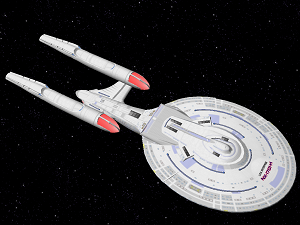 | |
| Affiliation: | Federation Starfleet |
| Service Period: | 25th - 26th Centuries |
| Length: | 850 meters |
| Width: | 315 meters |
| Height: | 115 meters |
| Mass: | 6,500,000 metric tons |
| Decks: | 30 |
| Crew: | 900 personnel 25,000 evacuation |
| Speed: | Warp 9.99 Coaxial Warp |
| Armament: | Phaser Arrays Phaser Banks Torpedo Launchers |
| Defenses: | S.H.I.E.L.D.S. |
| Auxiliary craft: | Mission Support Ship Starfleet Runabouts Starfleet Shuttlecraft |
Overview
With Starfleet’s return to five-year missions in the early 25th Century, the United Federation of Planets moved away from the construction of large scale exploration vessels to focus on smaller, more specialized exploratory craft that would excel at these shorter duration missions. While these versatile vessels performed their missions admirably, the ships and their crews were frequently overwhelmed during encounters with more technologically sophisticated and hostile species. Further, despite their successes, technological development and innovation stagnated throughout the Federation for the first time since the 22nd Century. Due to this the Federation Council and Starfleet Command looked for inspiration from the Starfleet Exploration Directive 1023.3 and the Perimeter Defense Directive to build their next generation explorer.Starfleet Command quickly ordered construction on three primary designs to serve as the next generation of Starfleet. The first vessel ordered was the Galaxy III Class, which would feature opulent diplomatic accommodations and exploratory capabilities. Soon afterward, Starfleet commissioned the Intrepid II Class, which would replace the Pathfinder Class with its state-of-the-art scientific abilities. Finally, the Sovereign II Class would be Starfleet's tactically oriented exploratory vessel, featuring enhanced offensive capabilities compared to its compatriots. Realizing that they had not commissioned a design that could fulfill these priorities in a single package, Starfleet Command directed the Corps of Engineers to begin work on the Constitution IV. Designed to be the heart of exploration and defense of the Federation, the Constitution IV was designed to be the leading research and exploration vessel in Starfleet.
Mission Profiles
Explorer, Scientific and Survey Missions, Strategic and Diplomatic Operations. Vessels of the Constitution IV Class are highly modular with much of their internal volume able to be customized to meet a variety of mission profiles without external Starfleet support. While highly automated, the crews assigned to ships of this class are among the best that Starfleet has available. This makes the Constitution IV Class capable of handling all mission profiles that Starfleet has to offer.
Technical Specifications
Physical Arrangement
Designed to be a workhorse of the fleet, the Constitution IV is a well rounded design intended for long-term exploratory missions beyond the Federation's territory. Considered part of the Constitution Class lineage, the vessel is 915 meters long, 515 meters wide, and has a height of 165 meters. The vessel is primarily constructed of a Duranium/Tritanium composite with an ablative armor enhanced outer defensive hull. The Enterprise has a standard crew complement of 900 persons, with a maximum evacuation capacity of 25,000 persons; however, later Constitution IV Class ships are more automated than the prototype and can function with only a handful of personnel aboard.The Enterprise features the traditional Saucer Section, Stardrive Section, Warp Nacelle configuration common to most Starfleet vessels and the ability to separate it's primary and secondary hulls into two units, each with their own independent systems, depending upon operational necessity through Saucer Separation. Normally used in high risk situations, Saucer Separation allows for nonessential personnel and noncombatants to vacate a danger zone while the secondary section remains behind to deal with the situation. In a reverse of standard operations, both sections of the ship are fully rated for combat while separated and both sections incorporate faster-than-light propulsion systems. Constitution IV Class vessels can reintegrate their sections without external support.
The exterior hull is constructed from Duranium/Tritanium composite plates that are attached to the vessel's skeletal structure, which is comprised of microextruded Terminium trusses mounted to the main trusses. High capacity primary and secondary Structural Integrity Field Generators produce specialized force fields to help the ship overcome compression stresses from its propulsion and other phenomenon. Inertial Dampening Fields, a series of variable-symmetry force fields, absorb and counteract the forces generated by the acceleration and deceleration involved with space travel. Through technologies reverse engineered from the Borg Cube Artifact in the early 24th Century, the Enterprise incorporates regenerative technology capable of completing minor repairs to the hull when suffering damage. Ablative hull armor surrounds the vessel to add further protection for the vessel and its occupants.
Constitution IV Class vessels have been constructed with additional capabilities over their predecessors in the Constitution lineage. Enterprise, as prototype for the design, has been enhanced with experimental Neutronium Alloy Fibers designed to strengthen the ship when exposed to extreme stress, including weapon's fire. The hull has been specially reinforced to allow for atmospheric travel when needed. Unlike all prior starships Enterprise, the Enterprise-H is capable of landing on a planet under controlled conditions and lifting off again without external support despite its size. The vessel incorporates antigravity generators and impulse thrusters that are strategically placed at the mass and stress points on the ventral hull to better aid in landing scenarios.
Command and Control Systems
Operational Control for the Constitution IV Class was provided by the Main Bridge located on Deck One of the ship. The Main Bridge is outfitted to oversee and control all shipboard functions and maintains active workstations for each member of the Senior Staff and all Department Heads. Primary workstations include the Captain’s Chair – located in the center of the Bridge – with the Flight Control Console (which oversees spaceflight operations) and Operations (which coordinates all shipboard operations) directly ahead. A large viewscreen sits at the front of the bridge offering holographic overlays that display data to assist with operations. Other workstations include a tactical workstation to control weapons and defenses, science stations to monitor sensor data and experiments, and engineering workstations monitoring shipboard systems. In the event of the Main Bridge losing function, control can be relegated to the Battle Bridge.
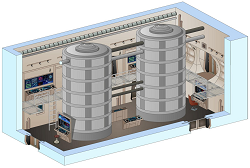 The main computer systems aboard the Constitution IV Class have heavily referenced the works of Doctors Noonien Soong, Bruce Maddox, and Agnes Jurati to produce a fully functional positronic matrix based artificial neural network computer system. Each matrix can store eight hundred quadrillion bits (100 petabytes) of memory and a base linear computational speed of roughly sixty trillion operations per second. The Positronic Matrix consists of 10 Computer Cores – six in the Primary Hull and four in the Secondary, but each section can be considered fully operational with a single functional core. Backup servers are available utilizing traditional isolinear circuitry should catastrophic failure of the primary cores occur. Further, due to the enhanced nature of the positronic components, the core structure utilized on vessels of the Constitution IV class are a fraction of the size of traditional bio-neural and isolinear cores.
The main computer systems aboard the Constitution IV Class have heavily referenced the works of Doctors Noonien Soong, Bruce Maddox, and Agnes Jurati to produce a fully functional positronic matrix based artificial neural network computer system. Each matrix can store eight hundred quadrillion bits (100 petabytes) of memory and a base linear computational speed of roughly sixty trillion operations per second. The Positronic Matrix consists of 10 Computer Cores – six in the Primary Hull and four in the Secondary, but each section can be considered fully operational with a single functional core. Backup servers are available utilizing traditional isolinear circuitry should catastrophic failure of the primary cores occur. Further, due to the enhanced nature of the positronic components, the core structure utilized on vessels of the Constitution IV class are a fraction of the size of traditional bio-neural and isolinear cores.
Due to the Positronic Matrix Computer Core each vessel of the Constitution IV Class has been outfitted with an Artificial Intelligence Monitoring System, also known as AIMS. Based upon software revolutionized by the EXEO Core, AIMS is an advanced artificial intelligence capable of billions of different tasks at once and helps to regulate shipboard functions.
Propulsion Systems
Faster Than Light Propulsion
Coaxial Warp Drive
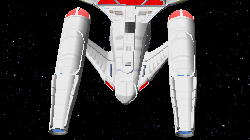 The next step in the evolution of the traditional Warp Drive, the Coaxial Warp Drive had long been the dream of Starfleet's Corps of Engineers with early work beginning in the 23rd Century. Inspired by the principles of the standard Warp Drives, the Coaxial Warp Drive creates a warp field and then “folds” space around the vessel by drawing in subatomic particles and reconfiguring their internal geometries. Antineutrinos serve as a catalyst for the space-folding process and create a neutrino envelope around the vessel to focus and amplify the space-folding process for travel. The Elway Theorem was an early challenge for the Coaxial Drive as each use of the system caused irreversible damage to passengers aboard the ship; which has been corrected in subsequent designs, but headache and nausea are still reported occasionally.
The next step in the evolution of the traditional Warp Drive, the Coaxial Warp Drive had long been the dream of Starfleet's Corps of Engineers with early work beginning in the 23rd Century. Inspired by the principles of the standard Warp Drives, the Coaxial Warp Drive creates a warp field and then “folds” space around the vessel by drawing in subatomic particles and reconfiguring their internal geometries. Antineutrinos serve as a catalyst for the space-folding process and create a neutrino envelope around the vessel to focus and amplify the space-folding process for travel. The Elway Theorem was an early challenge for the Coaxial Drive as each use of the system caused irreversible damage to passengers aboard the ship; which has been corrected in subsequent designs, but headache and nausea are still reported occasionally.Generating more energy in an instant than a conventional Warp Core produces in a year, at its maximum rated speed a vessel using a Coaxial Drive can travel 10 light-years a minute, but the system is still an experimental and still unproven technology that is not without risk. While the ship is not actually traveling within normal space eliminates the risk of accidental collision with space objects, the vessel utilizing the Coaxial Drive has an increased risk of propulsion system failure. Coaxial Warp Drives are prone to overload due to particle instability that can cause the system to malfunction and lose integrity. In the event of a catastrophic system failure the vessel utilizing the Drive will be destroyed and would collapse subspace for a range of up to 1 billion kilometers from the point of detonation. A polaric modulator can be used to dilute the particle stream as it enters the coaxial core, similar in nature to a carburetor utilized in automobiles, or a symmetric warp field can sometimes force stability in the drive. A chromoelectric field or pulse can be used to disable the system as a final method to stop the failure, but, should this fail, further safety protocols will implement to shutdown the Drive before catastrophic failure to try to protect the craft from severe subspace stress that can cause structural failure.
Should all safety protocols and efforts to disengage the Coaxial Drive fail, the Enterprise will be destroyed, everyone aboard the ship killed, and space will collapse for up to one billion kilometers surrounding the detonation zone.
Quantum Slipstream Burst Drive
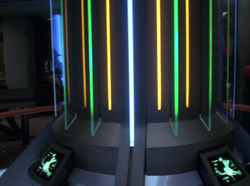 Based upon technology developed by Species 116 in the Delta Quadrant, the Quantum Slipstream Burst Drive is a scaled version of the traditional Quantum Slipstream Drive. Regulated through Benamite Crystals, the Drive operates by routing energy through the vessel's main deflector, which then focuses a quantum field to allow the vessel to penetrate the quantum barrier and travel through subspace at incredible speeds beyond traditional Warp capability. In order to maintain the Slipstream, the phase variance of the quantum field had to be constantly adjusted, or the slipstream would collapse and violently throw the ship back into normal space, potentially destroying the craft. As an experimental technology, the Drive requires extensive maintenance and is prone to system failure when overused.
Based upon technology developed by Species 116 in the Delta Quadrant, the Quantum Slipstream Burst Drive is a scaled version of the traditional Quantum Slipstream Drive. Regulated through Benamite Crystals, the Drive operates by routing energy through the vessel's main deflector, which then focuses a quantum field to allow the vessel to penetrate the quantum barrier and travel through subspace at incredible speeds beyond traditional Warp capability. In order to maintain the Slipstream, the phase variance of the quantum field had to be constantly adjusted, or the slipstream would collapse and violently throw the ship back into normal space, potentially destroying the craft. As an experimental technology, the Drive requires extensive maintenance and is prone to system failure when overused. While a traditional Quantum Drive could operate for long periods of time prior to recharge, the Quantum Slipstream Burst Drive was only able to operate for 30 minutes prior to forced shutdown, but the vessel will have traveled 150 light-years in this period. Afterward, the Enterprise's Engineers must reset and recharge the Drive, taking a minimum of 12 hours to successfully complete. The Enterprise can travel at conventional Warp while recharging.
Sublight Propulsion
Impulse Drive
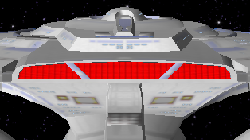 The Impulse Drive is the primary sublight propulsion system used aboard the Enterprise and is used to create impulse power in order to achieve slower-than-light speeds.
The Impulse Drive is the primary sublight propulsion system used aboard the Enterprise and is used to create impulse power in order to achieve slower-than-light speeds. Largely unchanged from the 22nd century to today, the Impulse Drive uses Newtonian principles to generate thrust and is, essentially an augmented fusion rocket, consisting of multiple fusion reactors, a driver coil assembly, and a vectored thrust nozzle to direct the plasma exhaust. When active, the fusion reaction generates a highly energized plasma that could be employed for propulsion or diverted through the Electro Plasma System to the power transfer grid, via EPS conduits, so as to supply other systems. When the accelerated plasma was passed through the Driver Coils Assembly, a subspace field that improved the propulsive effect was generated to enhance the vessel's speed. Each Impulse Engine is comprised of four of these assemblies and augmented by Impulse Capacitance Cells, specialized units which release a temporary burst of power to generate a burst of speed.
While Full Impulse is ¼ the speed of light, the Impulse Drive can be used to assist the vessel to travel at faster-than-light speeds in an emergency, albeit at a lower maximum speed and a higher rate of fuel consumption. This form of travel also increases the likelihood of the Enterprise experiencing relativistic effects, essentially completing an uncontrolled time jump through time dilation. Starfleet's Theoretical Propulsion Group are currently working on the development of Hyperimpulse Engines to overcome the time dilation risk, with a future member of the Constitution IV Class slated to test this upgrade.
Unlike previous Starfleet vessels, Constitution IV Class starships incorporate Impulse Thrusters as their Reaction Control System. Located at strategic points along the hull, the Reaction Control System (RCS), also known as “thrusters,” are used in situations where precise control of the ship’s travel are required. Functionally, Impulse Thrusters are miniature versions of a standard Impulse Engine and increase the turn rate for the Enterprise, but cannot propel the craft at the speed of a traditional Impulse Engine nor be tied into the vessel's power systems.
Scientific Systems
Laboratories
 Science Laboratories are specialized facilities aboard the Constitution IV Class that provide controlled conditions in which scientific or technological research, experiments, and measurement may be performed for work in experimental or observational science. In its current configuration, the Enterprise has been outfitted with General Science Labs that can be configured based upon mission parameters to fulfill objectives and a variety of specialized research laboratories throughout the vessel.
Science Laboratories are specialized facilities aboard the Constitution IV Class that provide controlled conditions in which scientific or technological research, experiments, and measurement may be performed for work in experimental or observational science. In its current configuration, the Enterprise has been outfitted with General Science Labs that can be configured based upon mission parameters to fulfill objectives and a variety of specialized research laboratories throughout the vessel. Featuring state of the art research facilities, the laboratories aboard the Enterprise are capable of performing both short and long-term research, providing detailed information and analysis into their subject of study. Enterprise also benefits from a series of modular laboratories, a series of compartments that can be configured for analysis and investigation depending on mission priority.
Probes
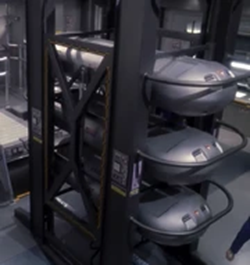 Probes are automated sensor platforms that are launched from the Torpedo Launchers of the Constitution IV to extend the range and sensitivity of the ship's sensors. The Federation employs nine classes of probe aboard Starfleet vessels with the probe's mission and capabilities typically designated by its number.
Probes are automated sensor platforms that are launched from the Torpedo Launchers of the Constitution IV to extend the range and sensitivity of the ship's sensors. The Federation employs nine classes of probe aboard Starfleet vessels with the probe's mission and capabilities typically designated by its number. Starfleet Probes use microfusion propulsion systems and warp field sustainers to travel with some featuring more capable internal propulsion systems that allow them to travel at higher speeds and with a greater range than others. Probes are fitted with an internal power cell to maintain function until they reach their maximum operating range and are programmed to self-destruct or can be remotely detonated from their mothership. All probes are rated for atmospheric operations with some designed to land on a planetary body to conduct scans and return to orbit. Most Starfleet Probes are constructed of modified Photon Torpedoes, consisting of a gamma-welded duranium-tritanium casing with a pressure bonded lufium boronate hull of two meters in length. Due to this, a Probe can be converted into a makeshift torpedo in an emergency.
Sensors
Consisting of multiple types, Sensors serve as a method for the Constitution IV to observe and study the universe around it. Sensors allow the vessel to detect not only visible phenomena, but an enormous number of electromagnetic and physical phenomena which traditional senses cannot detect. Sensors are rated on their range, strength and efficiency relative to their power levels, and their ability to overcome interference. Active sensor scans emit controlled energy pulses to collect and interpret data while passive sensor scans detect energy emitted by other objects or phenomenon. While advanced, sensors are not perfect and cannot routinely detect over 15,000 substances including some unusual, rare, and/or exotic materials because they occur so infrequently. Sensors can be recalibrated to detect these materials, but usually at the expense of another more routinely searched for item.Sensors used aboard Constitution IV Class vessels include:
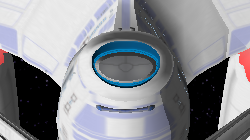 Lateral Sensors are located along the edge of a ship to maximize signal gain and are short-range sensor systems capable of detecting a variety of phenomena around the ship. Capable of both active and passive scans up to one light-year from the Enterprise, Lateral Sensors include six sensor pallets containing sensory equipment, but can be configured to incorporate mission specific technologies either by the crew or at a Starbase.
Lateral Sensors are located along the edge of a ship to maximize signal gain and are short-range sensor systems capable of detecting a variety of phenomena around the ship. Capable of both active and passive scans up to one light-year from the Enterprise, Lateral Sensors include six sensor pallets containing sensory equipment, but can be configured to incorporate mission specific technologies either by the crew or at a Starbase.- Long-Range Sensors are built into the Main Deflector Dish assembly and employ active scanning pulses to detect phenomenon or other objects at distance from the Enterprise. Consisting of multiple sensors pallets and telescopes, Long-Range Sensors work better at high resolution, but this limits their range to seven light-years. When utilizing medium-to-low resolution scans, range expands to a maximum of twenty light-years from the vessel.
- Navigational Sensors aid the Flight Control Officers in plotting courses and avoiding space debris. Incorporating the Guidance and Navigation (G&N) Relay, this system translates sensor data it into usable information for the pilots to effectively fly the starship.
Personnel aboard the Enterprise are able to employ one of three types of scans during routine operations. These include:
- Sensor Sweeps look at all area around the Enterprise and provide basic information about the environment around the ship.
- Sensor Search looks at a specific area around the vessel and provides more detailed information about an item.
- Focused Scans look at a particular are to provide detailed information at the expense of information gathering in other areas.
Tactical Systems
Defensive Systems
Ablative Hull Armor
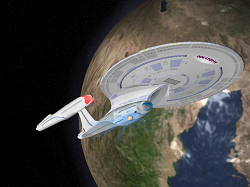 The last line of defense before the Enterprise's hull itself, Ablative Hull Armor is a specialized protective hull armor that can rapidly dissipate damage from directed energy weapon fire and projectiles.
The last line of defense before the Enterprise's hull itself, Ablative Hull Armor is a specialized protective hull armor that can rapidly dissipate damage from directed energy weapon fire and projectiles. Developed in the mid-24th Century as part of the Perimeter Defense Directive, Ablative Hull Armor is composed of a parametallic alloy consisting primarily of Monotanium. When a projectile weapon impacts the armor it is designed to explode outward to deflect the damage away from the vessel itself, similar to reactive armor from Earth's 20th Century. In the case of directed energy weaponry, the armor redistributes the energy across the hull until the energy exceeds the armor’s ability to compensate, leading the armor to begin to disintegrate while protecting the ship and crew from harm.
While the Ablative Armor offers enhanced protection and several advantages - including the ability to utilize Transporters in combat, it is not infallible. Once dissipated the armor cannot be regenerated independently by the vessel's crew and must be replaced by either a Drydock or Starbase. Chroniton particles can become lodged in the ablative armor matrix, potentially causing an uncontrolled temporal incursion by the vessel in certain conditions.
Deflector Shielding
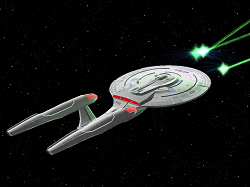 The primary defensive system aboard the Enterprise, Deflector Shields (or just Shields) protect the ship from damage inflicted by enemy forces, hazards, or other phenomenon. Activating automatically when the vessel enters Yellow or Red Alert, Shields are emitted from the Main Deflector Dish and are supplemented by the shield grid, a collection of emitters located at strategic points on the vessel's hull. Shields operate through the generation of a field of energetic distortion - with a high concentration of gravitons - around the vessel that absorb damage from hazards at the expense of shield energy. Divided into quadrants, with each impact the shield takes damage and cannot full recharge until the Deflectors are deactivated, but power can be rerouted from other shields or systems to reinforce the shield as long as it has not been fully depleted. Once shield energy has been fully lost, the hazard will begin to damage the vessel directly, harming both the ship and its crew in the process.
The primary defensive system aboard the Enterprise, Deflector Shields (or just Shields) protect the ship from damage inflicted by enemy forces, hazards, or other phenomenon. Activating automatically when the vessel enters Yellow or Red Alert, Shields are emitted from the Main Deflector Dish and are supplemented by the shield grid, a collection of emitters located at strategic points on the vessel's hull. Shields operate through the generation of a field of energetic distortion - with a high concentration of gravitons - around the vessel that absorb damage from hazards at the expense of shield energy. Divided into quadrants, with each impact the shield takes damage and cannot full recharge until the Deflectors are deactivated, but power can be rerouted from other shields or systems to reinforce the shield as long as it has not been fully depleted. Once shield energy has been fully lost, the hazard will begin to damage the vessel directly, harming both the ship and its crew in the process. With Starfleet's return to five-year missions in the early 25th Century, and a rise in threats to the safety and security of the Federation in the late 24th Century, Starfleet forces often found themselves in confrontation with more technologically sophisticated adversaries. As a result, Starfleet Tactical petitioned the Advanced Technologies Bureau to begin work on a next generation shielding system to be deployed alongside the Constitution IV and its cousins. Identified as the Starfleet High Intensity Energy Level Deflection System (aka S.H.I.E.L.D.S), this new deflector system employs a refracted lattice shield design and creates multiple deflector levels around the Enterprise when active. Still considered a prototype defensive array, S.H.I.E.L.D.S. incorporates the following shield types:
- Covariant Shielding is the innermost layer of the S.H.I.E.L.D.S. system and forms a hull conformal shield bubble directly around the hull of the Enterprise. Based upon technology encountered by the Starship Voyager while lost in the Delta Quadrant, Covariant Shields use tetryon based technology to generate force fields that are difficult to penetrate with conventional weaponry. Covariant Shields also have another benefit in that they are a natural form of Refractive Shielding, a countermeasure making detection by sensors difficult unless directly compensated for.
- Regenerative Shielding serves as the middle layer of the S.H.I.E.L.D.S. system and has the ability to regenerate itself when damaged. The shields operate by absorbing energy from shield impacts and then converting that energy into shield energy to recharge and reinforce the shield bubble. A compressed shield bubble, the regenerative layer is like any other shield in that once the shield collapses the regenerative abilities of the shield also fail, exposing the vessel to danger.
- Metaphasic Shielding is the outermost level of the S.H.I.E.L.D.S. system and forms a protective bubble around the ship. Designed by Ferengi Physicist Doctor Reyga, Metaphasic Shields are capable of withstanding the pressure, radiation and energy of a star's corona by generating overlapping low-level subspace fields to increase the subspace compression factor of the shields, which corresponds in a decrease of field distortion engaging the metaphasic field. When engaged a shielded object can withstand an impact equivalent to a Level 8 subspace shockwave.
Offensive Systems
Phaser Arrays
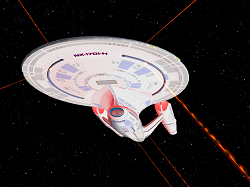 Phaser (short for PHASed Energy Rectification) Arrays are the primary weapon system aboard the Enterprise.
Phaser (short for PHASed Energy Rectification) Arrays are the primary weapon system aboard the Enterprise. Comprised of a linear arrangement of numerous Phaser emitters located in strategic areas of the starship, the Phaser Arrays channel vast energy in a short time frame, with the energy traveling along the emitter strip to find the best position for targeting. Shipboard Phasers are tied directly into the Warp Core, increasing the destructive power of the weapon while having the disadvantage of cutting off most or all phaser power if the Warp Core suffers an antimatter imbalance or if the reactor was damaged. To compensate for this in combat, the Phaser Capacitor - comprising multiple Phaser Power Cells - was developed to store energy for the Phasers during combat; however, these cells are quickly depleted depending upon the nature of combat.
Currently, the Constitution IV Class Enterprise employs the latest generation Type XV Phaser Arrays, which is a high–quality offensive Phaser capable of inflicting incredible damage on an opponent. Depending on the amount of energy available, Enterprise can fire its Phasers in either a fast or slow rate; however, the faster the rate of fire the lower the destructive potential of the Phaser against an opponent. Further, Phaser energy dissipates over distance, which means that a beam shot from long-range will do less damage than one shot from close range. Enterprise's Phasers could also be used to deliver a traceable payload, meaning that the impact of their weapons fire left residual ionic energy that could be used to track the target.
Torpedo Launchers
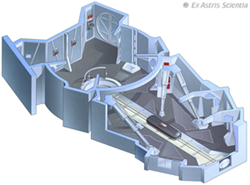 Designed for rapid fire, the Torpedo Launchers aboard the Enterprise can fire multiple projectiles more quickly and accurately that other similarly designed craft. Current projectile options aboard the Enterprise include:
Designed for rapid fire, the Torpedo Launchers aboard the Enterprise can fire multiple projectiles more quickly and accurately that other similarly designed craft. Current projectile options aboard the Enterprise include:
- Photon Torpedo: The Photon Torpedo is the primary heavy weapon aboard the Enterprise. A variant of the Photonic Torpedo developed by the Klingon Empire encountered in the 22nd Century, the Photon Torpedo uses the controlled detonation of matter and antimatter to deliver a devastating energy burst toward a target. Photon Torpedoes can be set with a proximity sensor to detonate prior to impact with a target, lessening the chance of a miss but also decreasing the damage inflicted. Photon Torpedoes can also be overloaded with additional energy to deliver a stronger impact, but this makes the torpedo unstable.
- Quantum Torpedo: Developed as part of the Perimeter Defense Initiative, the Quantum Torpedo was developed by Starfleet to help combat the Borg Collective. Based on the Photon Torpedo, the Quantum Torpedo discharges a higher amount of energy in a projectile of equal dimensions to its predecessor. Utilizing an eleven-dimensional space-time membrane suspended in ultra-clean vacuum within the projectile, the membrane in a Quantum Torpedo is
 twisted into a string and then isolated from the background vacuum resulting in the creation of a new particle and a tremendous release of energy. Like the Photon, a Quantum can be set to both overload and proximity settings.
twisted into a string and then isolated from the background vacuum resulting in the creation of a new particle and a tremendous release of energy. Like the Photon, a Quantum can be set to both overload and proximity settings.
Transport and Cargo
Cargo Bays
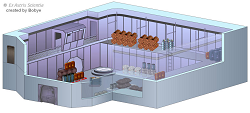 Located throughout the Constitution IV Class, Cargo Bays are general purpose storage facilities. Located throughout the Saucer and Stardrive Sections of the Enterprise, 485,000 cubic meters of cargo space are available aboard the vessel in its current configuration.
Located throughout the Constitution IV Class, Cargo Bays are general purpose storage facilities. Located throughout the Saucer and Stardrive Sections of the Enterprise, 485,000 cubic meters of cargo space are available aboard the vessel in its current configuration.Cargo Bays are used for the storage of consumables, equipment, and other objects and come in varying sizes with smaller Cargo Bays fitted in the Primary Hull and larger Cargo Bays located in the Stardrive Section. Several Cargo Bays have direct access to the exterior of the vessel through Cargo Bay Doors, large access points for cargo to enter or depart the ship. Workbees, extravehicular craft designed for short duration assignments, configured for Cargo Management are often stored within Cargo Bays with exterior access. Cargo Bays can also be equipped with Anti-Grav Units, Cargo Transporters and Tractor Beam emitters to assist in the moving of cargo containers. Several Cargo Bays incorporate Industrial Replicators, large-scale replicators designed for construction purposes, to support engineering tasks.
Cargo Bays aboard the Enterprise can be used in a variety of ways other than for the storage of equipment depending upon operational profile. Cargo Bays can be converted into Airponics/Hydroponics Bays to allow for the growth of foods for consumption during long-term, deep space assignments. In a period of medical emergency the Cargo Bay can be converted into triage centers - including stasis centers - to allow for wide scale treatment of injured patients. In law enforcement situations, the Cargo Bay can be converted into prison cells to transport prisoners.
Docking Bay
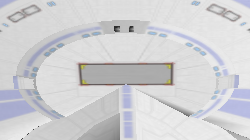 Located in the superstructure of the Primary Hull, the Docking Bay is a cavernous compartment where smaller starships or other vessels can dock for maintenance or to transfer supplies aboard the Enterprise. The largest single compartment aboard a Constitution IV Class vessel, the Docking Bay is accessed externally through a massive space door supported by a forcefield. Despite being part of the Enterprise herself, access to the section is via airlock. A large control room oversees the operations of the Docking Bay.
Located in the superstructure of the Primary Hull, the Docking Bay is a cavernous compartment where smaller starships or other vessels can dock for maintenance or to transfer supplies aboard the Enterprise. The largest single compartment aboard a Constitution IV Class vessel, the Docking Bay is accessed externally through a massive space door supported by a forcefield. Despite being part of the Enterprise herself, access to the section is via airlock. A large control room oversees the operations of the Docking Bay. Located centrally in the Docking Bay, the Enterprise's primary mission support ship, the U.S.S. Galileo Galilei, is suspended via a ceiling mounted docking pylon that connects it to the Enterprise while docked. Extensive maintenance facilities line the Docking Bay, as well as sophisticated Replicator and Tractor Beam equipment to assist with vessel recovery in an emergency situation. While not part of the Docking Bay, Guest Quarters and Cargo Bays are located near to the Docking Bay to support a visiting ship and its crew.
Support Craft
Garrison Ship
 The U.S.S. Galileo Galilei NCC-101564 (also called the Galileo) is a Libertas Class starship that was built at the Baikonur Orbital Complex, Earth in 2437. The Galileo Galilei has been assigned to the U.S.S. Enterprise as a mission support ship. Designed as a replacement for Starfleet's Nova Class, the Libertas Class is primarily utilized for planetary research, reconnaissance, and short-range exploration assignments not far from its mothership. Featuring an atypical, integrated design, the Galileo Galilei is three decks in height and incorporates twin Impulse Engines and Warp Nacelle that have been specially designed to operate at lower power levels to reduce the strain on the ship's reactors.
The U.S.S. Galileo Galilei NCC-101564 (also called the Galileo) is a Libertas Class starship that was built at the Baikonur Orbital Complex, Earth in 2437. The Galileo Galilei has been assigned to the U.S.S. Enterprise as a mission support ship. Designed as a replacement for Starfleet's Nova Class, the Libertas Class is primarily utilized for planetary research, reconnaissance, and short-range exploration assignments not far from its mothership. Featuring an atypical, integrated design, the Galileo Galilei is three decks in height and incorporates twin Impulse Engines and Warp Nacelle that have been specially designed to operate at lower power levels to reduce the strain on the ship's reactors.Maintained by a crew of 30 personnel drawn from the Enterprise's roster, the Galileo Galilei is not well suited for combat operations and features only two Phaser Arrays for defense and no torpedoes. For protection the ship has been outfitted with Metaphasic Shielding capable of withstanding the pressure, radiation and energy of a star's corona, but is heavily reliant upon its maneuverability and versatility to survive in combat. A small, rear facing shuttlebay houses a single shuttlecraft that can be used for secondary missions.
Runabouts
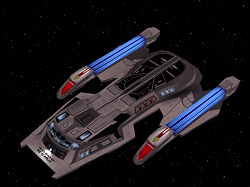 Successor to the Danube and Yellowstone Class Runabouts, the Polaris Class is the latest generation Runabout developed by Starfleet and are christened starships in Starfleet that carry a U.S.S. prefix. Formally christened in 2432, the Polaris Class is an auxiliary craft designed to be used as a base of operations for teams gathering scientific data and could offer assistance to survey teams in planetary and cultural surveys.
Successor to the Danube and Yellowstone Class Runabouts, the Polaris Class is the latest generation Runabout developed by Starfleet and are christened starships in Starfleet that carry a U.S.S. prefix. Formally christened in 2432, the Polaris Class is an auxiliary craft designed to be used as a base of operations for teams gathering scientific data and could offer assistance to survey teams in planetary and cultural surveys. Supporting a flight crew of four, Polaris Class vessels incorporate living space and mission configurable cargo capacities allowing the crew to maintain a six month mission before requiring resupply. Despite this, Polaris Class ships have more limited space when compared to prior runabouts. Capable of a maximum speed of Warp 7 for 12 hours as well as atmospheric flight, Polaris Class runabouts are lightly armored, highly maneuverable vessels armed with multiple Phaser Arrays and both forward and aft micro-torpedo launchers.
Assigned Runabouts
Members of the Polaris Class are named after stars and each runabout aboard the Enterprise is named after the home star of one of the Federation's founding worlds.
- U.S.S. 40 Eridani A
- U.S.S. 61 Cygni
- U.S.S. Procyon
- U.S.S. Sol
Shuttlebay
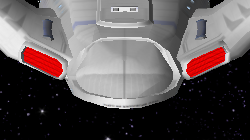 The Shuttlebay is a large facility on the Enterprise where shuttlecraft are launched, received, stored, and maintained. Overlooked by an Observation Deck, ships of the Constitution IV Class include three rear facing Shuttlebays - all in the secondary hull - that are supported by several hangars. A vehicle replicator, a large-scale replicator able to quickly create any small craft, is available to supplement the Enterprise during long duration missions.
The Shuttlebay is a large facility on the Enterprise where shuttlecraft are launched, received, stored, and maintained. Overlooked by an Observation Deck, ships of the Constitution IV Class include three rear facing Shuttlebays - all in the secondary hull - that are supported by several hangars. A vehicle replicator, a large-scale replicator able to quickly create any small craft, is available to supplement the Enterprise during long duration missions.In the 23rd Century Shuttlebay operations involved the depressurization of these shipboard facilities, during which time the space doors would open to allow access for spacecraft to the vessel. The implementation of forcefield technology allows the Shuttlebay to remain pressurized when spacedoors were opened. Due to specialized programming, the pressurization forcefields could be traversed by the vehicle while maintaining the pressurization of the Shuttlebay. While the docking procedure is highly automated, Tractor Beam Emitters are fitted to supplement the landing procedure of small craft in an emergency.
Support Craft
Type 18 Shuttlecraft
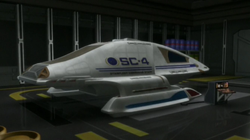 Based upon the Type 9 Shuttlecraft, the Type 18 Shuttlecraft is the most numerous aboard the Constitution IV Class U.S.S. Enterprise. In its standard configuration, the design can comfortably transport two flight crew and has an enlarged aft section behind the avionics bay to serve as a small cargo compartment. Through its high-performance warp nacelles, the Type 18 can maintain a cruising velocity of Warp 6 for six hours. Type 18 shuttles are lightly armed with Phasers, but can be fitted with a microtorpedo launcher and other defenses depending on mission profile.
Based upon the Type 9 Shuttlecraft, the Type 18 Shuttlecraft is the most numerous aboard the Constitution IV Class U.S.S. Enterprise. In its standard configuration, the design can comfortably transport two flight crew and has an enlarged aft section behind the avionics bay to serve as a small cargo compartment. Through its high-performance warp nacelles, the Type 18 can maintain a cruising velocity of Warp 6 for six hours. Type 18 shuttles are lightly armed with Phasers, but can be fitted with a microtorpedo launcher and other defenses depending on mission profile.The Type 18 incorporates advanced command and control features. By default a pilot can control the shuttle through tactile control consoles outfitted with LCARS touch interface, but the advanced artificial intelligence is also capable of utilizing voice commands to operate shipboard systems. Officers with an implanted synaptic transceiver in their brain can also control the Type 18 through thought alone via the sophisticated neural interface built into the craft.
Assigned Shuttlecraft
Type 19 Shuttlecraft
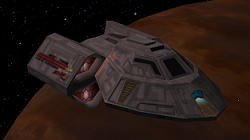 Inspired by the Type 10 Shuttlecraft developed during the Dominion War era, the Type 19 Shuttle is a small shuttle designed for long-range tactical assignments. Atypical from traditional shuttle designs, the Type 19 is equipped with compacted, armored integrated Impulse and Warp Drive assemblies. The top safe speed of this shuttle design is Warp 5.7, but some shuttles have been pushed to Warp 6 in an emergency situation.
Inspired by the Type 10 Shuttlecraft developed during the Dominion War era, the Type 19 Shuttle is a small shuttle designed for long-range tactical assignments. Atypical from traditional shuttle designs, the Type 19 is equipped with compacted, armored integrated Impulse and Warp Drive assemblies. The top safe speed of this shuttle design is Warp 5.7, but some shuttles have been pushed to Warp 6 in an emergency situation.Controlled by a three person flight crew, the pilot of the Type 19 shuttle is seated at a centralized console below the forward viewport. A Tactical workstation - located along the starboard bulkhead - controls the vessel's shields, Phasers, and micro-torpedoes while a port mounted console manages shuttlecraft systems and sensors. A small vestibule at the rear of the shuttle allows access to the craft and can be used for cargo transport.
Assigned Shuttlecraft
Type 19 Shuttlecraft aboard the Enterprise are named in honor of Captains of previous Starfleet starships named Enterprise.
- Christopher Pike
- Demora Sulu
- Elizabeth Shelby
- James T. Kirk
- Jean-Luc Picard
- John Harriman
- Rachel Garrett
- Robert April
- Spock
- Worf
Type 20 Shuttlecraft
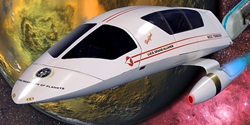 Designed for short-range missions, the Type 20 Shuttlecraft first entered service in 2435 and are the latest generation of shuttle in use by Starfleet. Designed to be manned by a flight crew of two with up to two passengers, the Type 20 Shuttle have little in the way of accommodations and emergency supplies for only one week. They make up for this deficit with their advanced Warp Drive, allowing the vessel to travel at a maximum velocity of Warp 6.8 for up to 12 hours. Lightly armed, the Type 20 features only a single forward Phaser.
Designed for short-range missions, the Type 20 Shuttlecraft first entered service in 2435 and are the latest generation of shuttle in use by Starfleet. Designed to be manned by a flight crew of two with up to two passengers, the Type 20 Shuttle have little in the way of accommodations and emergency supplies for only one week. They make up for this deficit with their advanced Warp Drive, allowing the vessel to travel at a maximum velocity of Warp 6.8 for up to 12 hours. Lightly armed, the Type 20 features only a single forward Phaser.The Type 20 Shuttlecraft is a sleek vessel and excels at atmospheric operations. Unlike previous shuttles, entry to the shuttle is provided by a cockpit canopy that opens to allow the pilot and co-pilot access to the vessel's controls. Access to the passenger compartment is provided by gull-wing doors built into the port and starboard bulkheads of the craft. A small staircase deploys from the underside of the craft, allowing passengers to board the vessel without interfering with the Warp Nacelles. Large viewports line the passenger compartment, giving unparalleled views of the environment around the vehicle.
Assigned Shuttlecraft
Tractor Beam
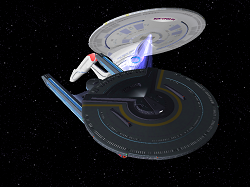 Tractor Beams are attenuated linear graviton beams used by starships, like the Enterprise, to control the movement of external objects. The device operates by placing spatial stresses on the object in specific areas, allowing it to hold the object in a fixed location or alter its position and/or trajectory. Most often used to tow a disabled or vulnerable ship to safety, or sometimes, used by an enemy ship to control the movement of the target vessel, tractor beams could also be set to repel objects.
Tractor Beams are attenuated linear graviton beams used by starships, like the Enterprise, to control the movement of external objects. The device operates by placing spatial stresses on the object in specific areas, allowing it to hold the object in a fixed location or alter its position and/or trajectory. Most often used to tow a disabled or vulnerable ship to safety, or sometimes, used by an enemy ship to control the movement of the target vessel, tractor beams could also be set to repel objects. Featuring multiple external emitters and individual internal units within the Shuttlebays, if a vessel's tractor beam is strong enough its graviton field can reinforce the structural integrity of a target vessel, keeping its hull from succumbing to stresses exhibited by a tractor field. Normally, Tractor Beams were used only at sublight velocities, but it was possible to tow a vessel at warp speed with some risk. The target vessel's engines had to be deactivated to avoid shearing forces against towing vessel and both vessels' speeds needed to be perfectly matched. A tractor beam could also be used to force another vessel out of Warp, but at extreme risk.
Transporters
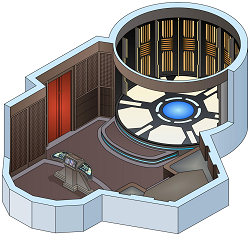 The Transporter is a subspace device capable of almost instantaneously transporting an object from one location to another. Vessels of the Constitution IV Class have multiple Personnel Transporter Rooms, which are overseen by a Transporter Chief responsible for the operational readiness, maintenance, and repair of the unit. Standard Transporters have a range of sixty thousand kilometers.
The Transporter is a subspace device capable of almost instantaneously transporting an object from one location to another. Vessels of the Constitution IV Class have multiple Personnel Transporter Rooms, which are overseen by a Transporter Chief responsible for the operational readiness, maintenance, and repair of the unit. Standard Transporters have a range of sixty thousand kilometers.A typical transport sequence, generally initiated by the request of the transportee to "energize", began with transporter pre-sequencing that led to transporter coordinates being established on the object or destination by the targeting scanners to establish a transporter lock. Simultaneously, the object was broken down into a stream of subatomic particles, called the matter stream, before being transferred to the pattern buffer, then again transferring to the emitter array. The matter stream was then transmitted to its destination across a subspace domain, leaving residual ionization in the air. As with other Starfleet technology, the transporter had its own set of safety features, protocols, and procedures. In an emergency, many of these safety systems could be modified or circumvented.
The Transporter saves the biological data of the individuals transported, often comparing the information obtained to an extensive preloaded pattern of common biology of all encountered species in the galaxy. Biofilters were used to decontaminate transported objects and prevent harmful substances, pathogens, and even certain forms of radiation, from contaminating the ship. Previously unknown infections or viruses occasionally failed to register with the biofilters, potentially allowing the threat to get through until the filters were recalibrated to recognize the new threat. Certain weapons could also be deactivated during the transport process.
Refits and Variants
Local construction methodologies have heavily influenced the production of Constitution IV Class starships. Vessels constructed at Earth have been constructed with experimental Neutronium Alloy Fibers to strengthen the hull, while the Andorian built vessels have greater ordnance protection. More advanced sensor systems have been produced at Vulcan while the Tellarite units have more efficient fusion reactors. While the Class Prototype features a dual Coaxial Warp Drive system, production line vessels have replaced the saucer Coaxial Drive with a Quantum Slipstream Drive due to the risk of catastrophic failure in vessels incorporating two Coaxial Drive Systems.
Despite its relative youth, Starfleet has completed several refit concepts for the Constitution IV to keep it on par with its contemporaries. Early refits have been designed to enhance the computational speed of the Positronic Matrix Computer Cores by converting the interlink sequencer to an asynchronous mode of operation, which removes performance constraints by having space between positronic links and allowing for greater automation. To better support the safety of the Constitution IV Class and its personnel, Point Defense Phaser Turrets are planned to allow for the automatic targeting of incoming projectiles.
During additional refits the Constitution IV Class will be outfitted with three torpedo types designed for the Sovereign II Class. The Quantum Cluster Torpedo, originally tested with the Aledo Class in the 24th Century, consists of a single projectile that splits into six separate microtorpedoes when within 500 meters of the designated target. The Polaron Torpedo, based upon Dominion Technology salvaged by the Klingons and shared through Khitomer Alliance Contracts, uses a modulating polaron radiation generator to bypass the shields of a target. The Tachyon Torpedo utilizes a burst of tachyons, particles which can only exist at faster than light speeds, to overwhelm the Warp Drive of an enemy craft, rendering the vessel inoperable upon unshielded impact.
Categories: No categories found